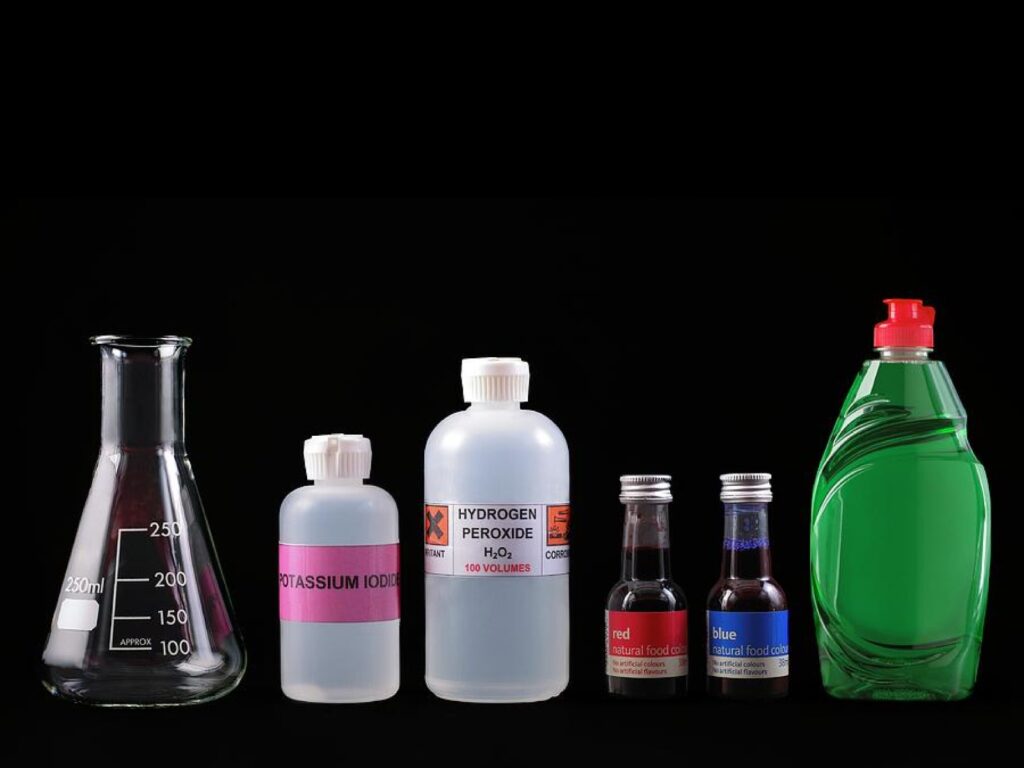When you use toothpaste, it always ends up making foam. Have you ever wondered the amount that would come out if you had to brush an elephant’s teeth? We suggest you find out with an experiment that will delight the children and with which you can explain how a chemical reaction takes place.
Stay tuned if you want to know how to make elephant toothpaste, an activity that always surprises by its dimensions. Furthermore, it is easy to do in the classroom or at home since you need few elements and all of them are very simple.
Materials Needed for Elephant Toothpaste Experiment
- 1 empty plastic soda bottle
- Dry yeast
- Water (neither too cold nor too hot)
- Dishwashing soap
- Hydrogen peroxide in a concentration of 3%.
- Plastic goggles
- 1 large tray
- Liquid food coloring
- 1 measuring cup
How to Make Elephant Toothpaste
In order to prevent the hydrogen peroxide from getting in contact with the children’s eyes, it is best to use plastic goggles. It will also give them a very scientific look.
In the following, we will explain how to make elephant toothpaste in 7 simple steps.
- Place the bottle inside the tray to avoid spills.
- Put half a cup of hydrogen peroxide inside the bottle.
- Add a good squirt of dishwashing soap and swirl the bottle gently until mixed.
- Add a little liquid food coloring. Shake again slowly.
- If you prefer to see streaks like toothpaste, drip a few drops of food coloring from the neck of the bottle. They will run down the sides and, as the elephant toothpaste grows, they will drag it down.
- In a bowl put one tablespoon of yeast powder and three tablespoons of warm water. Mix well.
- Pour the yeast into the bottle and stand back to observe the chemical reaction that occurs.
An Explanation on the Elephant Toothpaste Experiment
If you hear about hydrogen peroxide, you may not know that it is an element that you probably have in your medicine cabinet at home. We are talking about hydrogen peroxide, the same one you use to disinfect wounds and cuts. Hydrogen peroxide is made up of hydrogen and oxygen atoms, which kills bacteria.
As hydrogen peroxide breaks down, its elements disaggregate. The reaction takes place very slowly, but we can make it happen much faster by adding yeast.
At the moment in which the chemical reaction takes place, the hydrogen peroxide breaks down into two factors: on the one hand the liquid and on the other hand oxygen gas that forms the bubbles that come out of the container and explode.
In order to prevent the bubbles from disappearing we add dishwashing soap. Their task is to make them trapped and not to break. As a result, it will be as if you squeezed a giant tube of toothpaste and so much came out that you could brush an elephant’s teeth with it.
Alternatively, you can try making elephant toothpaste with no soap. In this case, while you will get some bubbles, there will be no foam. The dishwashing liquid is what causes the bubbles to have more surface tension and stay longer.
Also Read:
- What is Energy in Science?
- 23 Legendary Aircrafts that Made the History of Aviation
- How Chemistry Is Used in Everyday Life
- What Is Quantum Physics?
- Top 17 Aircrafts of the Future
- What Are Viruses? A Look at the Masters of Adaptation
Also, you can try adding two squirts instead of one and watch it grow even more. Leftovers from this activity can be washed down the sink as they do not cause problems in the pipes.
Besides making elephant toothpaste, an experiment that you can do with younger children and that serves to explain how the elements are made up of particles, here are some other activities that you can do with them at home or in the classroom.
What do you think about this activity? Have you ever done it before with your kids? If so, let us know any tips you’ve got about how to make elephant toothpaste in the comments section below.
